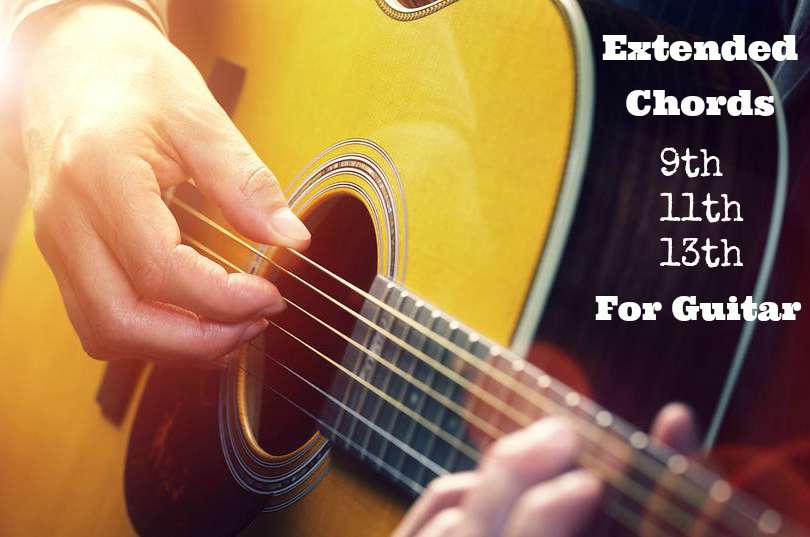September 4, 2023 by Klaus Crow

When I first learned the theory behind extended chords, it opened up a whole new world for me. All these mysterious chord names made finally sense.
I would use the chords for my own material, incorporate them into some of my favorite guitar songs and started learning some wicked jazz tunes.
Once you play around, experiment and incorporate these chords into your playing it will make guitar playing really fun and colorful.
If you’re new to chord construction then first check out How to Use Chord Formulas and Their Benefits and How to Play The Most Common Types of 7th Chords. These posts will give you the basic chord theory you need.
Let’s dive in…
Triads and 7th Chords
Extended chords are the 9th, 11th and 13th chords.
To understand the chord structure of extended chords we must first know the major and minor triad and three types of seventh chords. We use the “C” chord as an example to show the chord names.
The major chord consists of the root, third and fifth note of the major scale (1-3-5) = C
The minor chord consists of the root, flatted third and the fifth (1-b3-5) = Cm
The dominant 7th chord consists of the root, third, fifth and flatted seventh (1-3-5-b7) = C7
The minor 7th chord consists of the root, flat third, fifth and flat seventh (1-b3-5-b7) = Cm7
The major 7th chord consists of the root, third, fifth and seventh (1-3-5-7) = Cmaj7
As you can see chords are based on third intervals (1-3-5-7). To create the extended chord, we need to stack up another third interval.
9th Chords
For these three types of 7th chords there are also three types of 9th chords:
The dominant 9th, minor 9th and major 9th.
The dominant 9th chord consists of root, third, fifth, flatted seventh and ninth (1-3-5-b7-9) = C9
The minor 9th chord consists of root, flat third, fifth, flat seventh and ninth (1-b3-5-b7-9) = Cm9
The major 9th chord consists of the root, third, fifth, seventh and ninth (1-3-5-7-9) = Cmaj9

Notes: Extended chords have many notes. The thing is you have to deal with only six strings and practical chord fingerings so here and there you are allowed to omit some of the notes. In this case you can leave out the 5th because it’s the least important note. It doesn’t effect the overal sound of the extended chord.
Extended chords are extensions of the 7th chord, therefor the (b)7th is always present in the extended chord. Also the 9th seems here pretty important since it’s a 9th chord.
11th Chords
The three types of 11th chords are: dominant 11th, minor 11th and major 11th.
The dominant 11th chord: 1 – 3 – 5 – b7 – 9 – 11 = C11
The minor 11th chord: 1 – b3 – 5 – b7 – 9 – 11 = Cm11
The major 11th chord: 1 – 3 – 5 – 7 – 9 – 11 = Cmaj11

Note: The major 3rd and the 4th (4th is the same as 11th) clash and create dissonance (which doesn’t sound very pretty), therefor the third is often omitted in the C11 and Cmaj11 chord. Originally this would change the name of the chords. C11 becomes C9sus4. Cmaj11 becomes Cmaj9sus4. Still the chords are often notated as an 11th chord.
Also the 5th can be omitted. Leave in the (b)7th and the 11th.
13th Chords
The three types of 13th chords are: dominant 13th, minor 13th and major 13th.
The dominant 13th chord: 1 – 3 – 5 – b7 – 9 – 11 – 13 = C13
The minor 13th chord: 1 – b3 – 5 – b7 – 9 – 11 – 13 = Cm13
The major 13th chord: 1 – 3 – 5 – 7 – 9 – 11 – 13 = Cmaj13

Note: The 5th, the 9th and 11th can be omitted. Leave in the (b)7th and 13th.
An extended chord doesn’t change the quality of the chord it only adds more flavor to the overal sound.
Tip: All the extended chords shown above are closed chords and can be played in every key. The 1 is the root of the chord and determines the name of the chord. In the examples above the root note is “C”. Move any of the chords up a half step and “C” becomes “C#”, move up another half step and it becomes “D” and so on.
Assignments:
1 – Learn the extended chords in different keys.
2 – Experiment and substitute a dominant 9th chord for a dom7th chord when you play a song.
3 – Substitute a major 13th chord for a major 7th chord.
4 – Experiment using extended chords in songs.
5 – Memorize the extended chords in this post.
Have a great one!
Thank Info Mr
My Pleasure.
Best regards,
Klaus Crow
Very well explained.
This is fantastic. Understanding the notes you are playing helps to remember the chord shape(s). Great explanation of extended chords, thank you
Thanks for your help on 11th chords! Band-in-a-Box does not recognize 11ths and so I need to write them as 9th sus4. Thank you for pointing this out to me!
Would it be OK to copy and keep your explanation of 11th chords and their alternative 9th forms?